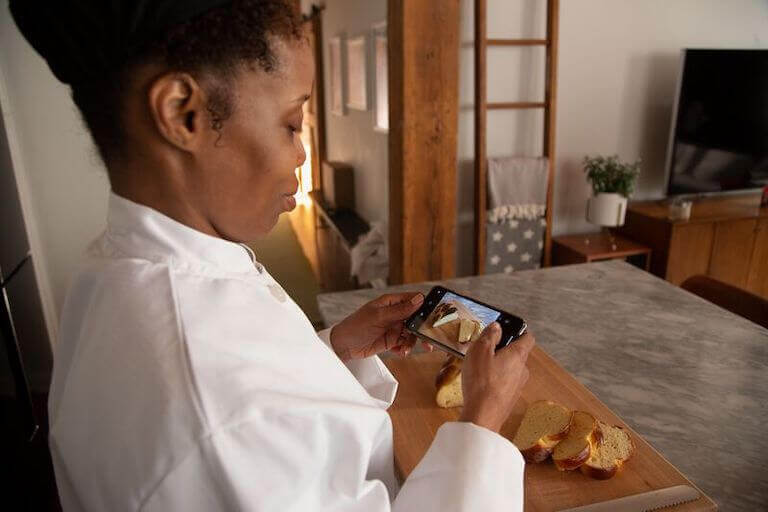Listen to This Article:
Perhaps you have an unrelenting desire to share your flaky chocolate croissants with the world, or you feel called to assemble nutrient-dense meals for business professionals. Whatever your passion might be, starting a food business from home could be the perfect arrangement.
Think about it—you might cut down on operating expenses without renting a commercial space. Plus, a home-based food business could allow flexibility if you have other “life” commitments. If you’re ready to start, keep reading to discover how to start a food business from home.
1. Pick Your Home-Based Food Business Idea
We might immediately think about selling baked goods from home since they’re relatively easy to package and sell (and most common). But there are a handful of creative food businesses to consider.
“This school and experience sparked two exciting new adventures for me: building my own allergy-friendly cookie business, Gaia Cookies, and starting a food blog for fun on the side, Cook ‘n’ Kickass – Food, Wellness, How-Tos & More.”*
Heather Arcay, Escoffier Culinary Arts Graduate
Sell Distinct Consumer Packaged Goods
Sure, you could bag up a few homemade blueberry scones straight from your kitchen…but think outside the box and consider other shelf-stable consumer packaged goods that might be highly sought after.
This could look like bottling homemade kimchi or pickled vegetables. Maybe you can sell grandma’s spicy marinara sauce in mason jars…or even organic baby food made with produce straight from your home garden. Finding your niche might help you stand out from the crowd.
Start Professionally Meal Prepping
With so many 9-5 multitasking workers, parents, and entrepreneurs, offering meal-prepping services could greatly improve someone’s daily life. Plus, meal-prepping is one of the fastest-growing industries in the US—with services like “meal kit” delivery expected to hit $64.4 billion in revenue by 2030.
If this is a viable option for you, think about how to serve your target demographic. Will you serve healthy meals that are ready to heat-and-eat, or niche down further to cater to plant-based or Keto diets?
Begin Home-Based Catering
With no brick-and-mortar shop, you can certainly start “off-site” catering from your home and deliver completed dishes to events. Like meal prepping, devise a menu that highlights your strengths, such as farm-to-table fare or plant-based catering.
Teach Virtual Cooking Classes
Did you know that the online cooking classes market is expected to reach $485 million by 2027? With more businesses offering remote services and more consumers seeking out virtual experiences, teaching online cooking classes could be worth exploring. Whether you teach how to cook northern Italian cuisine or specialize in French pastries, find ways to capitalize on your expertise.
2. Check Food Laws
Depending on the idea you decide to execute, there might be slight variations when it comes to abiding by food laws. First, it’s important to consult with your local food and business regulatory agencies to get the lay of the land. Also, if you’re operating out of your home, you’ll have to register with the FDA and then check your state and county’s local laws.
Cottage Food Laws
Governed by your local department of health, cottage food laws usually discern exactly what you can sell, labeling restrictions, product volume, and more.
In most states, you’ll have to get approved to sell from home and the following might be evaluated:
- Kitchen inspection
- Zoning permits and business licenses
- Pets may not be permitted, depending on state
3. Obtain Proper Business Licenses
Again, depending on your state and county, you will usually have to obtain the appropriate licenses and permits to begin operating from home. This is an essential step to potentially mitigate any legal disputes or penalties down the road. Registering your business also allows the government to collect taxes from your business. You can start obtaining these licenses by browsing the U.S Small Business Administration site.
4. Purchase Equipment
Whether you choose to sell consumer packaged goods or teach an online cooking class, start to take stock of the equipment you need and the quantity. This doesn’t have to be too complicated—a simple spreadsheet will do. Along with ingredients, think about packaging materials and labels as well.
Additional Equipment Checklist
- Extra refrigerator
- Blenders
- Mixers
- Knife kit
- Storage containers
- Various cutting boards
- Induction cooktop
- Venting for major appliances
- Microwave ovens
5. Calculate Costs
When it comes to how to start a food business from home, it’s important to anticipate the costs involved, it may likely be less than starting a restaurant. Without accounting for hiring staff or renting a commercial space, you might need to initially cover costs of ingredients, equipment, packaging, website/branding, and marketing. Also remember that if you’re building a business from home, you can claim some of your housing and utility costs when filing for taxes.

Food entrepreneur calculating food startup costs for latest catering venture.
When it comes to forecasting costs accurately, students enrolled in Escoffier’s Food Entrepreneurship program dive into the most pivotal food business fundamentals, which cover purchasing and cost control. The program then advances from the fundamentals of culinary math, operations, inventory, portion control, ingredient conversions, and recipe costing.
6. Design Your Brand
It’s time to flesh out the nuts and bolts of your home-based food brand and what the customer experience might look like. It might even be helpful to create a simple brand guide so you can reference it when building out your website and social media pages.
If you expand down the line and hire more employees, this may serve as a handy tool to potentially ensure marketing synchronicity. Here are a few more brand elements to consider.

Two entrepreneurs exploring branding for their food business.
Brand Name
This should reflect your overall brand essence and personality. Perhaps your brand name might echo a sentimental narrative. For example, restaurant owners Justin and Jaimie Buehler named their restaurant TABLE TWENTY-FIVE in Ogden based on a “first date” conversation. They discussed potentially starting a new restaurant while seated at “table 25” at a quaint, California-based eatery.
It’s always a good idea to make your brand name sweet, short, and punchy, so it’s easy to remember and reference for word-of-mouth marketing. Also when it’s time to come up with social media handles for Facebook and Instagram, a name that’s brief is ideal.
Color Palette
Choosing the right colors for your brand can activate an emotional connection with customers. Plan to select two or three colors that reflect your brand’s personality traits (i.e.,: modern, loud, playful, etc.). Once you solidify your color palette, use these for your branding across the board.
Website
With a strong brand name and cohesive color palette, it’s time to design your website. In the beginning, it might be best to use a simple, yet customizable template on Squarespace or Wix just to get you started. Try to include powerful call-to-actions, crisp imagery, legible fonts, and customer testimonials if you have them.
7. Reach Your Customers and Gain Exposure
When you’re first starting out, you might lean on your family and friends as your “exposure net”, which may mean writing online reviews or plugging your business name on social media. A strong foundation of 5-star reviews could potentially reach new customers, bolster consumer loyalty, and ignite more word-of-mouth marketing. This is more effective than you might think. According to WebFX, 92% of consumers trust recommendations over a company’s messaging. Just make sure that you’re not compensating your friends or family members for 5-star reviews, which violates the terms on most platforms.
Also when designing your packaging, make sure to keep social media at the forefront. For example, consider putting your Instagram and Facebook handles on your packaging so it’s easy for customers to promote your company.

Entrepreneur posting behind-the-scenes photos of the business.
A critical component of Escoffier’s Food Entrepreneurship program is hospitality marketing. Students can unpack how to influence consumers through applied marketing strategies. This program may also delve into how to create compelling social media content and blog in your brand voice.
Dive into How To Start a Food Business From Home
If you have a clear plan in place for your home-based food startup idea and cover your bases from a legal standpoint, you can start selling your products and services in no time. However, if you’re looking to take a deeper dive into each part of this process, Escoffier’s Food Entrepreneurship program might be for you!
In this setting, you can explore the applied marketing concepts, business planning methods, and core culinary principles which could prepare you to launch a business. If you’re ready to kick your concept into high gear, contact us today to discover more about our programs.
Enjoyed this food entrepreneurship article? Try these ones next!
- How to Start Your Own Food Truck
- Ghost Kitchens & Ghost Restaurants: What Are They and How do You Start One?
- 7 Side Hustles Great Cooks Can Start for Extra Cash
*Information may not reflect every student’s experience. Results and outcomes may be based on several factors, such as geographical region or previous experience.

